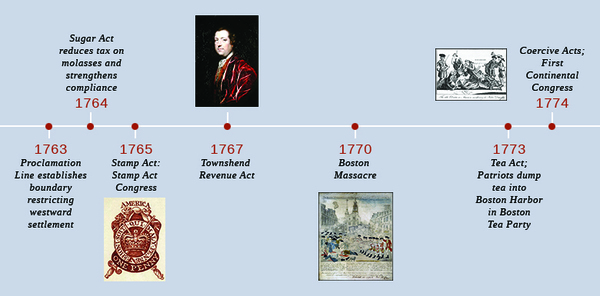| << Chapter < Page | Chapter >> Page > |

Great Britain had much to celebrate in 1763. The long and costly war with France had finally ended, and Great Britain had emerged victorious. British subjects on both sides of the Atlantic celebrated the strength of the British Empire. Colonial pride ran high; to live under the British Constitution and to have defeated the hated French Catholic menace brought great joy to British Protestants everywhere in the Empire. From Maine to Georgia, British colonists joyously celebrated the victory and sang the refrain of “Rule, Britannia! Britannia, rule the waves! Britons never, never, never shall be slaves!”
Despite the celebratory mood, the victory over France also produced major problems within the British Empire, problems that would have serious consequences for British colonists in the Americas. During the war, many Indian tribes had sided with the French, who supplied them with guns. After the 1763 Treaty of Paris that ended the French and Indian War (or the Seven Years’ War), British colonists had to defend the frontier, where French colonists and their tribal allies remained a powerful force. The most organized resistance, Pontiac’s Rebellion, highlighted tensions the settlers increasingly interpreted in racial terms.
The massive debt the war generated at home, however, proved to be the most serious issue facing Great Britain. The frontier had to be secure in order to prevent another costly war. Greater enforcement of imperial trade laws had to be put into place. Parliament had to find ways to raise revenue to pay off the crippling debt from the war. Everyone would have to contribute their expected share, including the British subjects across the Atlantic.
With the end of the French and Indian War, Great Britain claimed a vast new expanse of territory, at least on paper. Under the terms of the Treaty of Paris, the French territory known as New France had ceased to exist. British territorial holdings now extended from Canada to Florida, and British military focus shifted to maintaining peace in the king’s newly enlarged lands. However, much of the land in the American British Empire remained under the control of powerful native confederacies, which made any claims of British mastery beyond the Atlantic coastal settlements hollow. Great Britain maintained ten thousand troops in North America after the war ended in 1763 to defend the borders and repel any attack by their imperial rivals.
British colonists, eager for fresh land, poured over the Appalachian Mountains to stake claims. The western frontier had long been a “middle ground” where different imperial powers (British, French, Spanish) had interacted and compromised with native peoples. That era of accommodation in the “middle ground” came to an end after the French and Indian War. Virginians (including George Washington) and other land-hungry colonists had already raised tensions in the 1740s with their quest for land. Virginia landowners in particular eagerly looked to diversify their holdings beyond tobacco, which had stagnated in price and exhausted the fertility of the lands along the Chesapeake Bay. They invested heavily in the newly available land. This westward movement brought the settlers into conflict as never before with Indian tribes, such as the Shawnee, Seneca-Cayuga, Wyandot, and Delaware, who increasingly held their ground against any further intrusion by white settlers.

Notification Switch
Would you like to follow the 'U.s. history' conversation and receive update notifications?